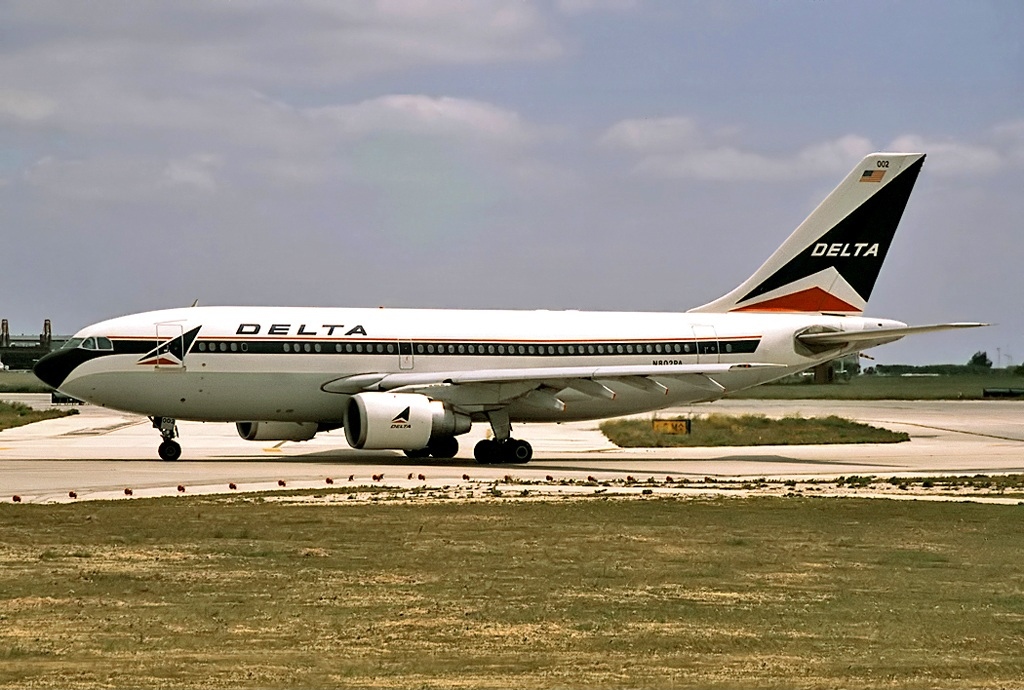The A310 was the first Airbus aircraft to join Delta Air Lines’ fleet. The Atlanta-based carrier first flew the widebody in November 1991. However, despite the milestone, the airline would only fly the jet for four years.

A new era
In 1991, there was a groundbreaking moment when Delta acquired the bankrupt Pan American’s transatlantic routes. Part of the purchase included hub operations at New York JFK and Frankfurt, Germany. The firm also took on Pan Am’s useful shuttle service.
The Delta Flight Museum shares that the deal included lease and purchase agreements for 45 aircraft. These planes included 21 Airbus A310s, which were split by the following:
- 7 Airbus A310-200 (three owned and four leased)
- 14 Airbus A310-300 (all leased)
The twinjet remains in limited service across the globe, but it was first introduced with Swissair in April 1983. Pan Am would become the first US airline to fly the plane when it entered service with the legendary carrier in 1985.
Delta’s purchase of Pan Am’s transatlantic routes and the Pan Am Shuttle made it the largest acquisition of flights in airline history. With this move, Delta well and truly became a global outfit.

Adapting to change
However, this feat came with some growing pains. According to The New York Times, Former Delta chairman and CEO Ronald Allen said that it took his firm up to four months to get the aircraft it had inherited from Pan Am into shape. Under their previous ownership, they had been heavily neglected.
Meanwhile, Delta SVP of Marketing Robert Coggin said Pan Am had crammed its A310s with 198 seats. This move made them uncomfortable for longer flights. Therefore, his company removed 15 to 18 seats from the jets to increase comfort in the cabin.
At the time, Delta was making significant progress in refurbishing its aircraft. Alongside these renovations, employee morale was being boosted while the airline was snapping up new passengers for international services.

Helpful revisions
The electronic flight instrument displays in the A310’s flight deck that replaced many of the standard analog dials on the main instrument panel were impressive additions for crews. Furthermore, the plane’s glass cockpit used six computer-driven cathode ray tube displays to show centralized information about the flight.
Another technical addition on the A310-200 was the use of lighter-weight carbon fiber reinforced plastic on secondary structures such as spoilers, airbrakes, and rudder. This model had a range of 3,925 statute miles and could reach speeds of 528 mph. Two Pratt & Whitney JT9D-7R4EI engines helped the plane across the skies.
Meanwhile, the Pratt & Whitney PW4152-powered – 300 had an increased maximum take-off weight, which was 337,300 lbs. Additionally, it had an increase in range, which was 4,830 statute miles. These abilities were supported by additional center and horizontal stabilizer fuel tanks.
This variant also used composites on primary structures and added drag-reducing wing-tip devices. There were improvements to fuel efficiency with these features.

Short-term solution
The Pan Am transaction would prove to be a key move for Delta. However, the A310 aircraft would not end up being a game-changer in the deal. The jets didn’t fly in the skies for very long with the airline’s livery.
The early 1990s was a challenging period in the economy. Therefore, the carrier had to initially reduce service on its new transatlantic routes to help reduce overall operating expenditure. Moreover, in 1993, nine of the former Pan Am A310s were replaced with fresh A310-300s leased from Airbus. Along with this, the remaining 12 Pan Am A310s were sent back to the European planemaker.
Subsequently, it didn’t take long for the leased units to also leave Delta’s holdings. By 1995, the airline didn’t operate the type again and replaced them with Boeing 767s. Nonetheless, when in service, the A310 mostly flew from New York to Europe, along with some other longer routes across the US.

The journey continues
Most of the carrier’s former A310s went on to specialize in cargo operations. The last one to leave the company ended up with FedEx before being stored last year. The others were mostly parked or scrapped by 2012 amid FedEx’s fleet overhauls.
However, not all of these widebodies went on to serve shipping routes as some went on to perform for other passenger carriers. Air India, Aerolineas Argentinas, Aeroflot, Air Jamaica, and Khalifa Airways all had former Delta A310s in their fleet over the years.
There would not be another Airbus type in Delta’s fleet for another 13 years. It would not be until the firm’s merger with Northwest Airlines when it would fly another jet from the manufacturer. From 2008 onwards, it went on to operate the A319, A320, A321, and A330. Moreover, it took on the A350 from 2017.
Today, only a handful of airlines operate the A310. Ariana Afghan Airlines, IranAir, Mahan Air, Taban Air, and Yemenia all have no more than two units in their holdings. Meanwhile, Royal Jordanian Cargo and Turkish Cargo still use the type for shipping services. Additionally, some militaries deploy the jet.
Looking back
Altogether, even though the A310 did not become a major player with Delta, it is a symbol of a significant turning point in the airline’s progress. The fall of Pan Am and Delta’s purchase of some of its important assets mark a notable transition in aviation history.
After decades of being a household name in the US, Pan Am finally fell. Meanwhile, Delta would continue to rise and be a mainstay as one of the big four carriers in the country.
What are your thoughts about Delta Air Lines’ Airbus A310 aircraft? Did you have a chance to fly on any of these planes at the time? Let us know what you think of the jets in the comment section.
[ad_2]
Source link


